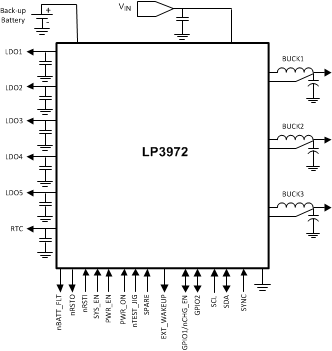SNVS468L September 2006 – November 2015 LP3972
PRODUCTION DATA.
- 1 Features
- 2 Applications
- 3 Description
- 4 Revision History
- 5 Device Comparison Tables
- 6 Pin Configuration and Functions
-
7 Specifications
- 7.1 Absolute Maximum Ratings
- 7.2 ESD Ratings
- 7.3 Recommended Operating Conditions
- 7.4 Thermal Information
- 7.5 Electrical Characteristics
- 7.6 Electrical Characteristics: LDO RTC
- 7.7 Electrical Characteristics: LDOs 1 to 5
- 7.8 Electrical Characteristics: Buck Converters SW1, SW2, SW3
- 7.9 Electrical Characteristics: Backup Charger
- 7.10 Electrical Characteristics: I2C Compatible Serial Interface (SDA and SCL)
- 7.11 Logic Inputs and Outputs DC Operating Conditions
- 7.12 I2C Compatible Serial Interface Timing Requirements (SDA and SCL)
- 7.13 Power-On Timing Delays
- 7.14 Typical Characteristics
-
8 Detailed Description
- 8.1 Overview
- 8.2 Functional Block Diagram
- 8.3 Feature Description
- 8.4 Device Functional Modes
- 8.5
Programming
- 8.5.1
LP3972 Reset Sequence
- 8.5.1.1
LP3972 Controls
- 8.5.1.1.1 Digital Interface Control Signals
- 8.5.1.1.2 Power Domain Enables
- 8.5.1.1.3 Power Domains Sequencing (Delay)
- 8.5.1.1.4 Power Supply Enable
- 8.5.1.1.5 Wake-up Functionality (PWR_ON, NTEST_JIG, SPARE and EXT_WAKEUP)
- 8.5.1.1.6 Internal Thermal Shutdown Procedure
- 8.5.1.1.7 Battery Switch and Backup Battery Charger
- 8.5.1.1.8 General Purpose I/O Functionality (GPIO1 And GPIO2)
- 8.5.1.1.9 Regulated Voltages OK
- 8.5.1.1.10 Thermal Management
- 8.5.1.1.11 Thermal Warning
- 8.5.1.1.12 LP3972 Thermal Flags Functional Diagram, Data from Initial Silicon
- 8.5.1.2 Initial Cold Start Power-On Sequence
- 8.5.1.3 Hardware Reset Sequence
- 8.5.1.4 Reset Sequence
- 8.5.1.1
LP3972 Controls
- 8.5.2 I2C Compatible Interface
- 8.5.1
LP3972 Reset Sequence
- 8.6
Register Maps
- 8.6.1
Serial Interface Register Selection Codes
- 8.6.1.1 System Control Status Register
- 8.6.1.2 Output Voltage Enable Register 1
- 8.6.1.3 Output Voltage Status Register
- 8.6.1.4 Output Voltage Enable Register 2
- 8.6.1.5 Output Voltage Status Register 2
- 8.6.1.6 DVM Voltage Change Control Register 1
- 8.6.1.7 Buck1 (VCC_APPS) Voltage 1
- 8.6.1.8 Buck1 (VCC_APPS) Target Voltage 2 Register
- 8.6.1.9 Buck1 (VCC_APPS) Voltage Ramp Control Register
- 8.6.1.10 VCC_comm Target Voltage 1 Dummy Register (CDTV1)
- 8.6.1.11 VCC_COMM Target Voltage 2 Dummy Register (CDTV2)
- 8.6.1.12 LDO5 (VCC_SRAM) Target Voltage 1 Register
- 8.6.1.13 LDO5 (VCC_SRAM) Target Voltage 2 Register
- 8.6.1.14 LDO1 (VCC_MVT) Target Voltage 1 Register (MDTV1)
- 8.6.1.15 LDO1 (VCC_MVT) Target Voltage 2 Register
- 8.6.1.16 LDO2 Voltage Control Register (L12VCR)
- 8.6.1.17 LDO4 - LDO3 Voltage Control Register (L34VCR)
- 8.6.2
TI-Defined Control and Status Registers
- 8.6.2.1 System Control Register 1 (SCR1)
- 8.6.2.2 System Control Register 2 (SCR2)
- 8.6.2.3 Output Enable 3 Register (OEN3) 8h’82
- 8.6.2.4 Output Enable 3 Register (OEN3) 8h’82 Definitions
- 8.6.2.5 Status Register 3 (OSR3) 8h’83
- 8.6.2.6 Status Register 3 (OSR3) Definitions 8h’83
- 8.6.2.7 Logic Output Enable Register (LOER) 8h’84
- 8.6.2.8 Logic Output Enable Register (LOER) Definitions 8h’84
- 8.6.2.9 VCC_BUCK2 Target Voltage Register (B2TV) 8h’85
- 8.6.2.10 VCC_BUCK2 Target Voltage Register (B2TV) 8h’85 Definitions
- 8.6.2.11 BUCK3 Target Voltage Register (B3TV) 8h’86
- 8.6.2.12 BUCK3 Target Voltage Register (B3TV) 8h’86 Definitions
- 8.6.2.13 VCC_BUCK3:2 Voltage Ramp Control Register (B32RC)
- 8.6.2.14 Interrupt Status Register ISRA
- 8.6.2.15 Backup Battery Charger Control Register (BCCR)
- 8.6.2.16 Marvell PXA Internal 1 Revision Register (II1RR) 8h’8E
- 8.6.2.17 Marvell PXA Internal 1 Revision Register (II1RR) (Ii1rr) 8h’8E Definitions
- 8.6.2.18 Marvell PXA Internal 2 Revision Register (II1RR) 8h’8F
- 8.6.2.19 Marvell PXA Internal 2 Revision Register (II1RR) 8h’8F Definitions
- 8.6.2.20 Register Programming Examples
- 8.6.1
Serial Interface Register Selection Codes
- 9 Application and Implementation
- 10Power Supply Recommendations
- 11Layout
- 12Device and Documentation Support
- 13Mechanical, Packaging, and Orderable Information
Package Options
Mechanical Data (Package|Pins)
- RSB|40
Thermal pad, mechanical data (Package|Pins)
Orderable Information
1 Features
- Compatible With Advanced Applications Processors Requiring Dynamic Voltage Management (DVM)
- Backup Battery Charger With Automatic Switch for Lithium-Manganese Coin-Cell Batteries and Super Capacitors
- I2C-Compatible High-Speed Serial Interface
- Software Control of Regulator Functions and Settings
- Thermal and Current Overload Protections
- Three Buck Regulators for Powering High-Current Processor Functions or I/Os
- Programmable VOUT from 0.725 V to 3.3 V
- Up to 95% Efficiency and 1.6-A Output Current
- ±3% Output Voltage Accuracy
- Six LDOs for Powering RTC, Peripherals, and I/Os
- Programmable VOUT of 1 V to 3.3 V
- ±3% Output Voltage Accuracy
- LDO_RTC 30 mA
- LDO1 300 mA
- LDO2 150 mA
- LDO3 150 mA
- LDO4 150 mA
- LDO5 400 mA
2 Applications
- Smart Phones
- Personal Media Players
- Digital Cameras
- Application Processors
- Marvell PXA
- Freescale
- Samsung
3 Description
The LP3972 is a multi-function programmable power management unit (PMU) designed especially for advanced application processors. The LP3972 is optimized for low-power handheld applications and provides six low-dropout low-noise linear regulators, three DC-DC magnetic buck regulators, a backup battery charger, and two GPIOs. A high-speed serial interface is included to program individual regulator output voltages as well as on and off control.
Device Information(1)
| PART NUMBER | PACKAGE | BODY SIZE (NOM) |
|---|---|---|
| LP3972 | WQFN (40) | 5.00 mm × 5.00 mm |
Simplified Schematic
